
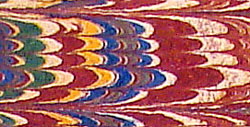 The decoration of the Dominican Missal of 1521 is at once visible in the exquisite marbling of slipcase, covers, and endpapers (see main webpage of the Dominican Missal). In addition, a great variety of well-executed woodcuts adorns the volume. The use of gradated fonts mimics the decorative writing style of manuscripts. The sheer numbers are impressive:
The decoration of the Dominican Missal of 1521 is at once visible in the exquisite marbling of slipcase, covers, and endpapers (see main webpage of the Dominican Missal). In addition, a great variety of well-executed woodcuts adorns the volume. The use of gradated fonts mimics the decorative writing style of manuscripts. The sheer numbers are impressive:
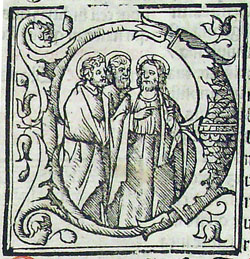 Although just one sixth of this missal, about one hundred pages, has been digitized, those pages alone feature 352 prints from woodcuts from nearly 300 individual designs. A particular cultural value of these woodcuts is in their presentation of biblical and liturgical knowledge. In addition they can be used to study a variety of topics including women in the Church, liturgical practices, even contemporary musical instruments, for several of these are shown in a headpiece.
Although just one sixth of this missal, about one hundred pages, has been digitized, those pages alone feature 352 prints from woodcuts from nearly 300 individual designs. A particular cultural value of these woodcuts is in their presentation of biblical and liturgical knowledge. In addition they can be used to study a variety of topics including women in the Church, liturgical practices, even contemporary musical instruments, for several of these are shown in a headpiece.
The present webpage discusses the woodcuts and the gradated fonts. At the end information on the famous Italian publisher is given. The University owns several books by this publisher, as part of The Gonzaga Collection: Rare Books from the Jesuit Heritage. These books are identified in the last paragraph below. Finally, possible projects for class or individual study are suggested at the end. The main webpage on the Dominican Missal has further information on several individual woodcuts and so should be read in conjunction with this page.
 Woodcuts in the Dominican Missal of 1521 are numerous and varied. Generously decorated openings (the two pages seen when the book is opened) are found at the start of major feasts\ and always include a big woodcut depicting the feast as well as a special large initial containing a scene associated with the feast. In addition one finds numerous vignettes depicting Gospel lections as well as portrait-woodcuts depicting biblical authors and saints. Historiated initials contain images of persons and even events. In addition, woodcut initials decorated with floral and vegetal motifs are found. Some distinctive liturgical woodcuts are also included. A small proportion of the woodcuts are repeated in this missal, but most appear in it only once. Each category of woodcut is treated below, with examples. The text-area on the Dominican Missal's page is 35 lines high, and the woodcuts range in height from 29 lines down to two lines.
Woodcuts in the Dominican Missal of 1521 are numerous and varied. Generously decorated openings (the two pages seen when the book is opened) are found at the start of major feasts\ and always include a big woodcut depicting the feast as well as a special large initial containing a scene associated with the feast. In addition one finds numerous vignettes depicting Gospel lections as well as portrait-woodcuts depicting biblical authors and saints. Historiated initials contain images of persons and even events. In addition, woodcut initials decorated with floral and vegetal motifs are found. Some distinctive liturgical woodcuts are also included. A small proportion of the woodcuts are repeated in this missal, but most appear in it only once. Each category of woodcut is treated below, with examples. The text-area on the Dominican Missal's page is 35 lines high, and the woodcuts range in height from 29 lines down to two lines.
The title page sports two woodcuts: a large portrait of St. Dominic, and, at the foot of the page ... the printing device of Luca Antonio Giunta, the famous publisher. For a PDF of this page, click on the image at left. For more on Giunta, see the end of this webpage.
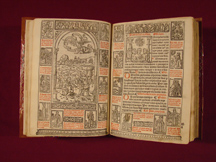 Decorated openings start every major feast in this missal. Each such opening is decorated with twenty-nine woodcuts arranged in the layout seen here. Shown here is the start of the liturgy for Christmas dawn (fols. 9v-10). Click on the image for its PDF. The regular alternation of small woodcuts and red captions frames each page. These smaller woodcuts include prophets who foretold the event celebrated in the feast, details of the event, and sometimes events from the Old Testament which foreshadowed the event in the life of Christ. For instance, for a Marian feast Moses is depicted before the burning bush, because Christians interpreted the bush which burned but was not consumed as a foreshadowing of Mary who was a mother but did not cease to be a virgin (fol. 171v, top right).
Decorated openings start every major feast in this missal. Each such opening is decorated with twenty-nine woodcuts arranged in the layout seen here. Shown here is the start of the liturgy for Christmas dawn (fols. 9v-10). Click on the image for its PDF. The regular alternation of small woodcuts and red captions frames each page. These smaller woodcuts include prophets who foretold the event celebrated in the feast, details of the event, and sometimes events from the Old Testament which foreshadowed the event in the life of Christ. For instance, for a Marian feast Moses is depicted before the burning bush, because Christians interpreted the bush which burned but was not consumed as a foreshadowing of Mary who was a mother but did not cease to be a virgin (fol. 171v, top right).
The book's largest woodcuts (29 lines high) are found consistently on the left page of each decorated opening and always depict the feast. That largest woodcut always is framed above and below by a headpiece (usually Christ amid the twelve apostles) and a floral tailpiece. Along each outer side of the page is a column of four small woodcuts (7 lines high), each with a rubricated caption. Below the largest woodcut is another pair of small woodcuts, with a floral piece between them. A geometric tailpiece runs across the page as a whole. On the right page this layout is repeated, except that here the largest woodcut (12 lines high) is a special initial depicting the feast and beginning the feast's opening antiphon. This woodcut does not have its own tailpiece. On both pages of such openings the marginal woodcuts depict prophecies of the feast and elements of it.
Three different headpieces are shown In the six fully decorated openings on this website: The most frequently used one presents Christ, in a cruciform halo, amid the twelve apostles, en buste (as seen in the opening above, on the left side). The other two depict holy women. One shows the Virgin Mary amid ten holy women, en buste. This headpiece is seen on the first decorated opening and again on fol. 16v. The other depicts a richly detailed coronation of the Blessed Virgin Mary. That headpiece is seen in the opening above on fol. 10, also on fol. 12. The mother of Jesus sits centrally on a low throne, so that though enthroned she remains in a humble position. The Trinity is crowning her: Christ at the left, God the Father at the right, and overhead the Holy Spirit in the form of a dove. Surrounding this group is an angelic choir playing a variety of instruments. Note that in the opening shown above, as on some other openings, the headpieces provide a balance of the sexes, with male saints on one side and female on the other.
The fully decorated openings available for viewing online are for the Annunciation (the opening with fol. 1), Christmas Eve (fols. 7v-8), Christmas dawn mass, with a large miniature of the angel's announcement to the shepherds (fols. 9v-10, shown above), the adoration of the shepherds (fols. 11v-12), the circumcision of the Lord (fols. 14v-15), Epiphany, with a large miniature of the Adoration of the Magi (fols. 16v-17), Palm Sunday, with Christ's Entry into Jerusalem (fols. 63v-64). Also, the section of the Missal concerned with feasts of saints begins with the feast of St. Andrew, with the Calling of Simon and Andrew (fols. 155v-156). Finally, online images (but not PDFs) are available for the feast of All Saints (fols. 232v-233) and for the feast of one or more apostles (fols. 238v-239).
 On the righthand pages of these openings, the feast-specific large initials (12 lines high) show King David in an A beginning one of his psalms (fol. 1), Christ in a D (fol. 8, shown here), the coruscating Star of Bethlehem in the L of "Lux" (light, fol. 10), a nativity scene in a P (fol. 12), Christ returning to his mother after his circumcision (fol. 15), an angel proclaiming the birth of Christ (fol. 15v), the Adoration of the Magi (fol. 17), a monk kneeling in prayer before the face of God (fol. 29v), and Christ with two disciples in a D (fol. 64). The largest such initial, fully sixteen lines high, shows Andrew (or Peter?) leaping from their fishing boat toward Jesus to answer his call (fol. 156).
On the righthand pages of these openings, the feast-specific large initials (12 lines high) show King David in an A beginning one of his psalms (fol. 1), Christ in a D (fol. 8, shown here), the coruscating Star of Bethlehem in the L of "Lux" (light, fol. 10), a nativity scene in a P (fol. 12), Christ returning to his mother after his circumcision (fol. 15), an angel proclaiming the birth of Christ (fol. 15v), the Adoration of the Magi (fol. 17), a monk kneeling in prayer before the face of God (fol. 29v), and Christ with two disciples in a D (fol. 64). The largest such initial, fully sixteen lines high, shows Andrew (or Peter?) leaping from their fishing boat toward Jesus to answer his call (fol. 156).
In some images the termini (ends) of the letter containing the depiction are decorated with grotesque faces, as seen in the initial D at left (click on the image for a PDF of the opening with that initial.) Sometimes the grotesque faces can be large, as in the historiated initial S on fol. 171v (not yet digitized).
Every Gospel lection is represented in a miniature (13 lines high), always placed at the start of the pertinent reading. These pictures include Jesus' entry into Jerusalem (fol. 1v), John the Baptist in prison (fol. 2v), John the Baptist declaring that he is not the Christ (fol. 6v), the decree of Caesar Augustus with Joseph and Mary shown obeying it (fol. 8v, also seen in the upper right of fol. 7v), the encounter of the infant Jesus with Symeon in the Temple (fol. 14), the angel warning Joseph in a dream (fol. 16), the Magi (fol. 17v), Mary and Joseph finding the child Jesus teaching in the Temple (fol. 18), John baptizing Jesus in the Jordan (fol. 19), the wedding at Cana (fol. 19v), Jesus healing a leper (fol. 20v), Jesus calming the sea (fol. 21), the parable of the vineyard workers ("the last shall be first" -- fol. 22v), the parable of the sower and the seed (fol. 23v), Jesus prophesying his Passion to the disciples (fol. 24v, used again with his teaching the disciples how to fast, fol. 27), Jesus and the Centurion (fol. 27v), Jesus and his disciples with a city in the background (fol. 28v), a different depiction of Jesus calming the sea (fol. 29), the Temptation of Christ (fol. 30), Jesus foretelling his Second Coming (fol. 31), Jesus chasing the money-changers from the Temple (fol. 31v), Jesus asked by the scribes and Pharisees for a sign (fol. 32v), and Jesus questioned by a crowd and the Pharisees (fol. 33v).
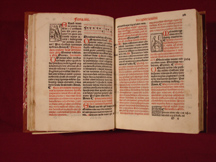 Two liturgical vignettes for Ash Wednesday appear on the opening of fols. 25v-26, shown here. Each woodcut is eight lines high. On the righthand page is seen the distribution of ashes on Ash Wednesday. The woodcut is adjacent to the words the priest speaks then: "Memento q[uod] cines es et in cinerem reverteris" ("Remember that you are ashes and into ashes you shall return"). The print shows a vested priest putting ashes on the crown of the head of a kneeling man. A woman is next in line to receive ashes, so this woodcut shows the balance of the sexes.
Two liturgical vignettes for Ash Wednesday appear on the opening of fols. 25v-26, shown here. Each woodcut is eight lines high. On the righthand page is seen the distribution of ashes on Ash Wednesday. The woodcut is adjacent to the words the priest speaks then: "Memento q[uod] cines es et in cinerem reverteris" ("Remember that you are ashes and into ashes you shall return"). The print shows a vested priest putting ashes on the crown of the head of a kneeling man. A woman is next in line to receive ashes, so this woodcut shows the balance of the sexes.
Portraits. Saints and biblical authors are the subjects of woodcuts thirteen lines high. Portraits include St. Anastasia (fol. 11), St. Andrew (fol. 156 at lower right), and the evangelists John (fol. 13), and Luke (fols. 3v, 10v, 15v) and Matthew (fol. 21v) and probably Mark on a folio not yet digitized. In addition, some portraits appear in historiated initials (seven lines high), namely King David in an A (fols. 21 and 21v), St. Lawrence in a C (fol. 22), and Sts. Peter and Paul in the two halves of a capital M (fol. 6). Another portrait of King David is included in the decoration of the first major feast, in the large historiated initial A (twelve lines high) which begins an antiphon based on one of his psalms (fol. 1). Many of these woodcuts are "author portraits," showing the author of the biblical text being quoted. Small portrait woodcuts are also found along the sides of the fully decorated openings. For instance, the prophet Isaiah who foretold the virgin birth is shown in a woodcut, third down on the left side, on fol. 171v, for the feast of the Purification of Mary.
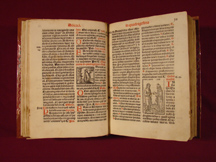 Historiated initials. Nearly a score of historiated initials (seven lines high) are viewable online. There are four different D's, three E's and a pair each of A's, C's and G's. In alphabetical order the designs are an A with a tonsured man who gestures with his right hand (fol. 20), an A with King David praying (fols. 21 and 21v) -- the initial is repeated with an antiphon which quotes from a psalm, because the entire Psalter was believed to have been composed by David -- a C with St. Lawrence with his gridiron (fol. 22), a C with a head facing to the right (fol. 33), a D with the newborn Christ and God the Father in Glory (fol. 13v), a D with a half-length figure (fol. 27), a D with a turbaned man's head (fol. 33v), an E with a monk kneeling, praying, being blessed by a standing monk (fol. 24), an E with an executioner with a sword standing behind a haloed, kneeling man (fol. 23), an E (starting the liturgy for the Octave of Epiphany) with four happy infants (fol. 18v), a G with a monk (prefatory page), a G with eleven haloed figures (fol. 2v), an H with a turbaned man who gestures with his left hand (fol. 6), an O with a vested priest at an altar (fol. 19v), a P with a man with a scroll (fol. 1v), and a Q with a man with a book (prefatory page).
Historiated initials. Nearly a score of historiated initials (seven lines high) are viewable online. There are four different D's, three E's and a pair each of A's, C's and G's. In alphabetical order the designs are an A with a tonsured man who gestures with his right hand (fol. 20), an A with King David praying (fols. 21 and 21v) -- the initial is repeated with an antiphon which quotes from a psalm, because the entire Psalter was believed to have been composed by David -- a C with St. Lawrence with his gridiron (fol. 22), a C with a head facing to the right (fol. 33), a D with the newborn Christ and God the Father in Glory (fol. 13v), a D with a half-length figure (fol. 27), a D with a turbaned man's head (fol. 33v), an E with a monk kneeling, praying, being blessed by a standing monk (fol. 24), an E with an executioner with a sword standing behind a haloed, kneeling man (fol. 23), an E (starting the liturgy for the Octave of Epiphany) with four happy infants (fol. 18v), a G with a monk (prefatory page), a G with eleven haloed figures (fol. 2v), an H with a turbaned man who gestures with his left hand (fol. 6), an O with a vested priest at an altar (fol. 19v), a P with a man with a scroll (fol. 1v), and a Q with a man with a book (prefatory page).
Other initials. Some initials are decorated simply, with flowers or leaves. Each is four lines high: a floreate A (fol. 28), a vegetal R (fol. 32), a vegetal S (fol. 30v), and a floreate V (fol. 4v). Also, a few initials which are simply larger than the normal type face of the missal are used, as a guide to the eye. Printed in red, these initials draw the eye to the start of a text. Thus, the initials C, F, O, and F are in red in the righthand column of fol. 29v. In the lefthand column is an initial P. On the facing page (fol. 30) in the righthand column the Gospel lection begins with a red, two-line high initial I. In imitation of medieval manuscripts, printers would follow a tall initial by a capital letter as tall as the rest of the text, and then by lower case letters. Thus one sees "PRepara" in the left column of fol. 29v and "CElistis" in the right column there. Aesthetically, it is more pleasing to go from a tall letter to a somewhat smaller one before returning to the usual size of letter.
The Publishers. The Dominican Missal of 1521 was printed by Luca Antonio Giunta, member of the Giunta publishing dynasty and founder of the Venetian branch of the company. Though this particular volume was published by him in Venice, as attested by the colophon, his printer's device on the title page has the lily of Florence centrally, evidently a reference to his city of origin. "The Gonzaga Collection: Rare Books from the Jesuit Heritage" also holds six other volumes published by his heirs at Venice: a Controversarium (published by Giunta in 1541) (Inv. No. P46), an edition of Aristotle's De rhetorica (1550) formerly owned by the Jesuit novitiate at Sheridan, Oregon (Inv. No. A55), St. Thomas Aquinas' Summa Theologica (1612; Inv. No. T48) and his commentary on Apocalypse (1562; Inv. No. T29), a commentary on Aristotle's logic by the Jesuit Francisco de Toledo (1578; Inv. T64), and a compendium of moral theology by the Jesuit Henrico Henriquez (1596; Inv. H14). In addition the Foley Library owns a facsimile edition of the 1522 Giunta edition of the Quaestiones by Pope Adrian VI.
Projects: Possible projects using the woodcuts of the Dominican Missal of 1521 include the following. Some involve examining how the image represents a biblical text. The English version of the Bible closest to what the illustrator knew is the Douai Rheims translation, so if possible use that translation. If you read Latin, use the Vulgate.
1. Select a decorated opening at the head of a major feast and study the small woodcuts. Compare them to the ones on the following pages. Are any prints reused in the pages presenting the rest of the liturgy begun on the opening? At least sometimes the Gospel lection woodcut appears in both places, as on fols. 7v and 8v.
2. Look at several decorated openings and study the small woodcuts. The headpieces and tailpieces are reused. Are any other small woodcuts reused? Which ones are used on every decorated opening?
3. Select a lection woodcut. Read the lection it illustrates. What details did the artist select for depiction? How else might that reading have been illustrated in a single picture?
4. If you read Latin, then you can do this project: Consider the liturgical vignettes on fols. 25v and 26. Do they represent the liturgical directions and texts beside these woodcuts?
5. Identify all the woodcuts depicting monks and priests. Do any of them, or all of them, represent the liturgical directions and texts they are depicted next to?
6. A martyrdom is depicted on fol. 23, in the initial E of "Exurge, q[ua]re obdormis, d[omi]ne: exurge et ne repellas" (Psalm 43:23). An executioner with a sword raised is shown standing behind a haloed, kneeling, praying man. Does anything indicate whether this is a general depiction or a specific saint?
7. Identify the saint depicted on fol. 18 in the initial I of "In excelso throno." He has a crucifix beside him and he holds a book and a flower (flowering rod?).
8. One of the headpieces shows the virgin Mary in the midst of ten female saints. It is often paired on an opening with the headpiece showing Jesus in the midst of the twelve disciples. Is ten, the number of the women with Mary, significant? Is it possible to determine who those women they are? Or even if they are symbolic or intended to be specific historical women?
9. Consider the large woodcut on the titlepage. Is it possible to identify the four saints flanking St. Dominic? For instance, is the woman St. Catherine of Sienna (1347-1380), doctor of the Church? What do St. Dominic's attributes, the book and flower, represent? Why is a triple crown held by the angel at the upper right? Is there a reason for the specific depiction of Christ that is used here?
10. For additional projects on depictions of women in the Dominican Missal of 1521, go to the bottom of the page you reach by clicking here.
Dr. Catherine Brown Tkacz
Special Consultant to the President for Rare Books and Manuscripts
August 15, 2009